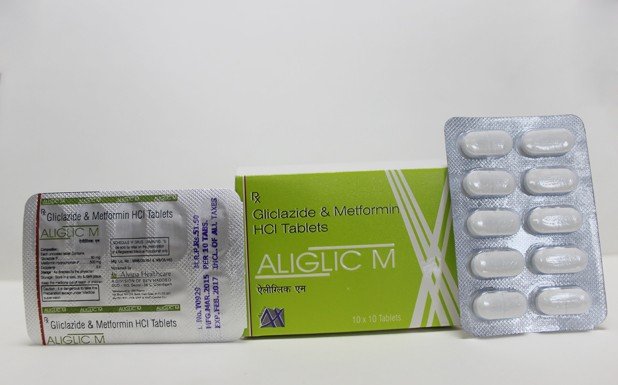
Composition
- Each Film Coated Tablet Contains:
- Gliclazide IP
80 mg
- Metformin HCL
500 mg
Packing
- 10x1x10
Blister
MRP
- 51.50
Overview
Aliglic-M is a combination of two medicines: Gliclazide and Metformin Hydrochloride which is used in Type-2 diabetes mellitus. Gliclazide augments the level of insulin created by the body. It is a sulfonylurea which works by increasing the amount of insulin released by the pancreas to lower the blood glucose.Insulin is a hormone that assists the body to utilize the sugar in the blood correctly and it aids to stop the blood sugar count from getting too high. Metformin is a biguanide which lowers glucose production in the liver, delays glucose absorption from intestines and increases the body's sensitivity to insulin.
Indications
- IDiabetes mellitus
- Hyperlipoproteinaemia
- Insulin dependent diabetes mellitus
- Insulin resistance
- Non-insulin dependent diabetes mellitus
- Obesity
Mechanism of action:
Glipizide and Metformin HCl combines are two antihyperglycemic agents with complementary mechanisms of action, to improve glycemic control in patients with type 2 diabetes. Glipizide appears to lower blood glucose acutely by stimulating the release of insulin from the pancreas, an effect dependent upon functioning beta cells in the pancreatic islets. Extrapancreatic effects may play a part in the mechanism of action of oral sulfonylurea hypoglycemic drugs.Stimulation of insulin secretion by Glipizide in response to a meal is undoubtedly of major importance. Metformin hydrochloride is an antihyperglycemic agent that improves glucose tolerance in patients with type 2 diabetes, lowering both basal and postprandial plasma glucose.It decreases hepatic glucose production, decreases intestinal absorption of glucose, and improves insulin sensitivity by increasing peripheral glucose uptake and utilization.
Pharmacology
Pharmacodynamics Properties of Gliclazide:
Gliclazide is an oral sulfonylurea hypoglycemic agent which stimulates insulin secretion.Gliclazide is a second generation sulphonylurea which acts as a hypoglycemic agent. It stimulates β cells of the islet of Langerhans in the pancreas to release insulin. It also enhances peripheral insulin sensitivity.It potentiates insulin release and improves insulin dynamics.
Pharmacokinetics Properties of Gliclazide:
ABSORPTION: Rapidly and well absorbed. Peak plasma concentrations occur within 4-6 hoursDISTRIBUTION: Through the portal circulation, it reaches liver and is distributed to the body fluids.
PROTEIN BINDING: 94%, highly bound to plasma proteins
METABOLISM:Metabolized in the liver. Metabolites include oxidized and hydroxylated derivates, as well as glucuronic acid conjugates.
EXCRETION:Metabolites and conjugates are eliminated primarily by the kidneys (60-70%) and also in the feces (10-20%).
HALF-LIFE: 10.4 hours. Duration of action is 10-24 hours.
Pharmacodynamics Properties of Metformin Hydrochloride:
Metformin is an oral antihyperglycemic agent that improves glucose tolerance in patients with NIDDM, lowering both basal and postprandial plasma glucose. Metformin is not chemically or pharmacologically related to any other class of oral antihyperglycemic agents. Unlike sulfonylureas, metformin does not produce hypoglycemia in either patients with NIDDM or healthy subjects and does not cause hyperinsulinemia. Metformin does not affect insulin secretion.
Pharmacokinetics Properties of Metformin Hydrochloride:
ABSORPTION: It is slowly and incompletely absorbed from the gastrointestinal tract.BIOAVAILABILITY: approximately 50% to 60%.
DISTRIBUTION: Metformin is negligibly bound to plasma proteins. It crosses the placenta and is distributed into breast milk in small amounts.
METABOLISM: Metformin is excreted unchanged in the urine. Metformin is not metabolized.
EXCRETION: Metformin is eliminated by glomerular filtration and tubular secretion.
HALF LIFE:6.2 hours. Duration of action is 8-12 hours.
CONTRAINDICATIONS
It should not be taken if you have the following conditions : Type 1 DM, Diabetes Complicated With Ketoacidosis; Hypersensitivity; Severe Renal And Hepatic Impairment.
SIDE EFFECTS
- Nausea
- GI symptoms
- Dry mouth
- Diarrhoea & mild stomach pain
- Headache
DRUG INTERACTIONS
Certain drugs tend to produce hyperglycemia and may lead to loss of blood glucose control. These drugs include the thiazides and other diuretics, corticosteroids, thyroid products, Miconazole, Phenylbutazone , Danazol, Chlorpromazine, phenytoin, salbutamol, terbutaline.
PREGNANCY AND LACTATION
Pregnant and lactating women should take this medication only under the prescription of the physician